Are you a Quiet Speculation member?
If not, now is a perfect time to join up! Our powerful tools, breaking-news analysis, and exclusive Discord channel will make sure you stay up to date and ahead of the curve.
Nothing is harder to see than the obvious. This is the problem of teaching Magic to new players. Whether you humiliatingly miss an on-board win, or your "missing" keys are on the table right in front of you, it happens to everyone. It can even apply to knowledge. It is easy to forget how daunting your field is to newcomers. To you, a given step is so obvious that it doesn't bear mentioning, and you forget that isn't true for everyone. It may even be something that is unnecessary for you, but only because you know how to safely cut that corner. There are very important lessons about how to play the game that are so intuitive to experienced players we forget that it actually isn't obvious. It gets worse once you start delving deeply into theory.

I'm bringing this up because I realized I skipped something important. Last year, I covered the basics of sideboarding, and some advanced techniques. I thought I'd covered everything. I was wrong. There was another technique that is a strategy unto itself. It was just so obvious to me that I had no reason to think about it, much less write it out. Then, I was asked about my strategy for the Jeskai control mirror, where I just slam Geist of Saint Traft and ride him to victory. Some were confused; doesn't card advantage decide control mirrors? The exception was so intuitive to me I assumed everybody knew. I deliberately go all-in on being the aggressor.
I do this so that I don't have to fight over being the control deck. That is a fight I cannot reliably win because I rarely pack mirror-breakers. Crucible of Worlds in conjunction with Ghost Quarter, extra card draw, or unanswerable threats provide some advantage that wins the game unassisted in the control mirror---and are, quite frequently, poor everywhere else, so I don't play them. Instead, I become the beatdown, which my opponent is unprepared for, and just overwhelm them. Today's article is about effectively utilizing this repositioning and counterboarding strategy.
Non-Conventional Wisdom
The basics of sideboarding are well-established: take out bad cards, put in good cards. Nice, simple, and teachable. Exactly what makes a card "good" or "bad" can be easily explained in the matchup's context, yielding an easy system for new players to learn with. Then, experience teaches the nuances and alternatives derived from that basic structure.
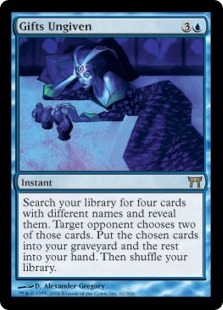 Historically, sideboard strategy has simply extended this logic. Control versus control was about who was the better control deck. The first time I heard about this was during PT Philidelphia 2005 in relation to the Gifts Ungiven mirror. It was said that whoever played draw-go longest while still making land drops had the advantage and "should" win. I heard this reiterated for years regarding control mirrors (I recall some event where commentators discuss the merits of choosing to draw in the mirror, but I can't find the clip). On the opposite end, aggro mirrors were thought to depend on playing first. This makes quite a bit of sense. If your and your opponent are situated to take a certain role, whoever executes it worse should lose.
Historically, sideboard strategy has simply extended this logic. Control versus control was about who was the better control deck. The first time I heard about this was during PT Philidelphia 2005 in relation to the Gifts Ungiven mirror. It was said that whoever played draw-go longest while still making land drops had the advantage and "should" win. I heard this reiterated for years regarding control mirrors (I recall some event where commentators discuss the merits of choosing to draw in the mirror, but I can't find the clip). On the opposite end, aggro mirrors were thought to depend on playing first. This makes quite a bit of sense. If your and your opponent are situated to take a certain role, whoever executes it worse should lose.
The better control deck and/or control player was always assumed to be advantaged. But I'd heard a different message, and it worked for me.
Wisdom of the Ancients
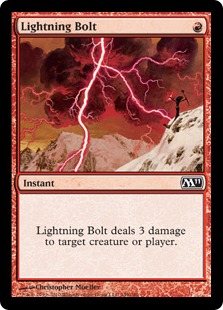 If nothing else, this article series has served to dredge up important old articles. One article that spoke to me and developed my sideboarding was already old when I got serious about competitive Magic: Mike Flores's "Why Dave Price Goes Second." Take a minute to read this article before we continue. Flores was arguing that when decks are similar card advantage matters most. It doesn't have to be about two-for-ones, though that helps. The way that the true mirror matches play out, everything trades equally because all the cards are the same. Therefore, the player who drew second will win. Expanding the idea, any two similar decks will have some advantage in something, and you should focus on that thing primarily. You can gain the advantage just by playing fewer lands (drawing more action), having superior tempo, or having better mana sinks and the ability to wield them. The key is identifying which advantage lies with which player and plan accordingly.
If nothing else, this article series has served to dredge up important old articles. One article that spoke to me and developed my sideboarding was already old when I got serious about competitive Magic: Mike Flores's "Why Dave Price Goes Second." Take a minute to read this article before we continue. Flores was arguing that when decks are similar card advantage matters most. It doesn't have to be about two-for-ones, though that helps. The way that the true mirror matches play out, everything trades equally because all the cards are the same. Therefore, the player who drew second will win. Expanding the idea, any two similar decks will have some advantage in something, and you should focus on that thing primarily. You can gain the advantage just by playing fewer lands (drawing more action), having superior tempo, or having better mana sinks and the ability to wield them. The key is identifying which advantage lies with which player and plan accordingly.
When I read "Why Dave Price Goes Second," the fact that the deck on the draw was advantaged in the mono-red beatdown mirror floored me. The concept disagreed with everything I'd heard. To be fair, I wasn't sophisticated enough as a player to really get any of that, but one idea stuck: for the most part, when decks do similar things, card advantage wins unless there's something inherently non-interactive about the matchup, as Flores explains at the end of the article. If that's the case, you should focus on that to the exclusion of all else. Over time, this principle has developed into my repositioning strategy.
The Reposition Sideboard
When I approach a mirror match, or a match against another deck operating on a like axis to mine, I start by determining which role my opponent is likely to take. This is pure "Who's the Beatdown?". If my opponent is a control deck and wants to sideboard to be more of a control deck, and I don't/can't play cards to really break open that matchup, I will take the opposite role. In past UW control mirrors, I've cut a lot of slower permission and card advantage spells to play more Vendilion Clique and Geist of Saint Traft. What I'm doing is shifting position so I can dodge opponent's more powerful cards and play a game they weren't expecting. This is also useful if you believe your opponent is more skilled than you and will therefore win a long game.
A reposition is similar to transformative sideboards, but not as extreme. Rather than make a dramatic shift, you've altered your strategy based on your opponent's intended attack. Here's the principle illustrated:
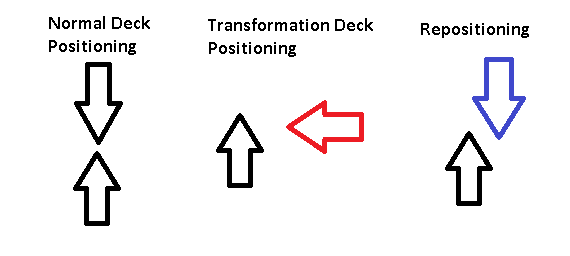 I am simplifying this, but when two decks oppose each other, they tend to attack each other on one axis. Control vs. aggro being consistently about threats is one example. When you transform, you have pivoted to an entirely new axis; one utterly different from your initial gameplan. When you reposition, you're shifting out of the way of the incoming attack. It's not about dramatically changing your gameplan, but invalidating your opponent's strategy. It's picking the ground where you are ready and advantaged to fight on.
I am simplifying this, but when two decks oppose each other, they tend to attack each other on one axis. Control vs. aggro being consistently about threats is one example. When you transform, you have pivoted to an entirely new axis; one utterly different from your initial gameplan. When you reposition, you're shifting out of the way of the incoming attack. It's not about dramatically changing your gameplan, but invalidating your opponent's strategy. It's picking the ground where you are ready and advantaged to fight on.
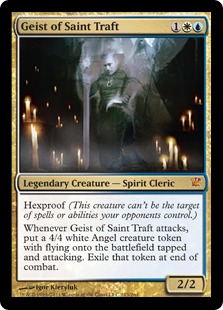 You never want to fight on your opponent's terms. They picked that ground for a reason; do you really want to be Lee at Gettysburg? It's much better to be the one deciding how the battle will unfold. In the earlier UW example, I wasn't going to win the prison/control game that my opponent anticipated, so I became more of a tempo deck. Long-game cards are meaningless against Geist. If you can't win the fight, win a different one first.
You never want to fight on your opponent's terms. They picked that ground for a reason; do you really want to be Lee at Gettysburg? It's much better to be the one deciding how the battle will unfold. In the earlier UW example, I wasn't going to win the prison/control game that my opponent anticipated, so I became more of a tempo deck. Long-game cards are meaningless against Geist. If you can't win the fight, win a different one first.
I should note that this is not appropriate for all decks or matchups. You do need to plan ahead to make it possible, and even then, your main strategy may not allow it. Humans is going to be basically the same deck pre- and post-board no matter what you do, so why try there? Even if you dedicated considerable sideboard space to the idea, the manabase would still limit your options.
Repositioning in Action
Let's apply this theory to the original Jeskai example. Most guides will advise you to play more attrition cards and Negate. Taking that into account, remove slower permission spells, since you're not aiming for a long game, in favor of the full set of Geists and extra Dispels. That gives you the advantage in resolving and protecting Geist and winning the game before attrition starts to matter.
This is also where my UW Merfolk deck shone. It's game one plan was not dramatically different from mono-blue, we play fish and attack. Having the white allowed me to take a different tack post-board against creature decks. Merfolk is neither explosive nor very fast, but it is overwhelming. Eventually, you go bigger but you survive that long. This makes it vulnerable to fast aggro, especially Affinity, Elves, and Humans. Accepting this fact gave me the option to take a more controlling role. By running white I had hard removal that didn't cost life and the option for more, namely Sunlance and Condemn. This gave me the option to play a longer game, trade creatures, and gradually come out ahead. Had I stuck to the accepted plan of being the better aggro deck, I would have performed worse because I started out as the worse aggro deck.
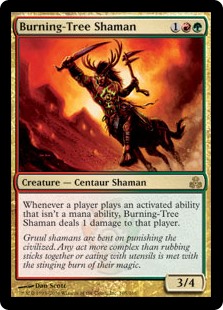 For an older but much clearer example, think back to Ravnica/Time Spiral Standard. The default aggro deck of the day was Gruul Aggro. It had all the best (read: biggest) creatures at the low slots, including Tarmogoyf. It was hard for other decks to compete in the same space. I was running Boros Aggro and absolutely crushed crushed the Gruul decks that Regionals. My deck ran 20 creatures, 20 burn spells, and 20 lands, and I was using Boros Garrison to cheat on land. The typical Gruul deck was mostly creatures and ~22 lands. I had Inherent Card Advantage (go back to Dave Price), so I just embraced it. I traded every creature I played, burned all of their creatures, used Jotun Grunt to contain Tarmogoyf, and I won the attrition fight every time.
For an older but much clearer example, think back to Ravnica/Time Spiral Standard. The default aggro deck of the day was Gruul Aggro. It had all the best (read: biggest) creatures at the low slots, including Tarmogoyf. It was hard for other decks to compete in the same space. I was running Boros Aggro and absolutely crushed crushed the Gruul decks that Regionals. My deck ran 20 creatures, 20 burn spells, and 20 lands, and I was using Boros Garrison to cheat on land. The typical Gruul deck was mostly creatures and ~22 lands. I had Inherent Card Advantage (go back to Dave Price), so I just embraced it. I traded every creature I played, burned all of their creatures, used Jotun Grunt to contain Tarmogoyf, and I won the attrition fight every time.
When it came time to sideboard, I fully embraced this control reposition strategy. My weak creatures came out for more burn and protection from red creatures and I had a pretty easy matchup. My opponents never saw it coming and weren't ready.
Exercise Discretion
Be careful with this strategy. You don't want to get too clever or dodge into a tree. It's very easy to try this and make either the wrong adjustment or have your opponent anticipate you and lay an ambush. It may not even go that far; they could just chose a different strategy than expected. Then you're the one out of position. Be careful and use it wisely.
Counterboarding
No, I don't mean adding more counterspells to your sideboard (necessarily). The other very common strategy that never gets spelled out is counterboarding. This is where you sideboard to directly answer your opponent's sideboard/overall strategy and advance your own. It's not just about having answers; it's about invalidating the intended strategy organically.
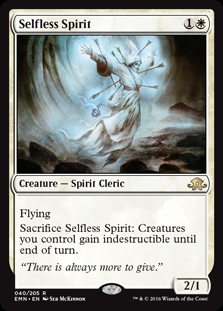 You see this often in control verses aggro matchups, though it's everywhere. Sweepers are very powerful against creature aggro, so you expect control decks to have a lot of them after-board. Sideboarding into Selfless Spirit or Heroic Intervention completely negates this plan. You anticipated your opponent's sideboarding strategy and shut it down. This is normal boarding. The counter designation applies to the Spirit, which actively advances your gameplan while also answering their strategy. Intervention, like Brave the Elements, is just an answer; Spirit actively wins the game. That's a true counterboard. Counterboarding requires answers that proactively advance your core gameplan.
You see this often in control verses aggro matchups, though it's everywhere. Sweepers are very powerful against creature aggro, so you expect control decks to have a lot of them after-board. Sideboarding into Selfless Spirit or Heroic Intervention completely negates this plan. You anticipated your opponent's sideboarding strategy and shut it down. This is normal boarding. The counter designation applies to the Spirit, which actively advances your gameplan while also answering their strategy. Intervention, like Brave the Elements, is just an answer; Spirit actively wins the game. That's a true counterboard. Counterboarding requires answers that proactively advance your core gameplan.
One of the best recent examples is the adoption of Ghirapur Aether Grid by Affinity. The card isn't very effective by itself, but as an answer to Stony Silence, it's phenomenal. In slower matchups, Affinity has the time to build up non-creature artifacts that are otherwise useless and just ping an opponent to death. Stony hurt, but you got around it with a card that is reasonable on its own.
For another example, look to Xathrid Necromancer out of the Humans sideboard. It synergizes with the rest of the deck, and neutralizes otherwise deadly sweepers from control. Well, except for Anger of the Gods. Which is what Meddling Mage is for.
Ideally, every sideboard slot would work this way, but that isn't always possible. Sometimes you just need hosers or reactive answers instead of threats. Still, counterboarding is a powerful way to switch up your gameplan and gain a considerable edge. Just don't shoot yourself in the foot trying.
Keep Learning
So, that was my epiphany for the week. But I'm sure there are more "obvious" lessons out there that I haven't thought to discuss. Can you think of any? Let me know in the comments.





